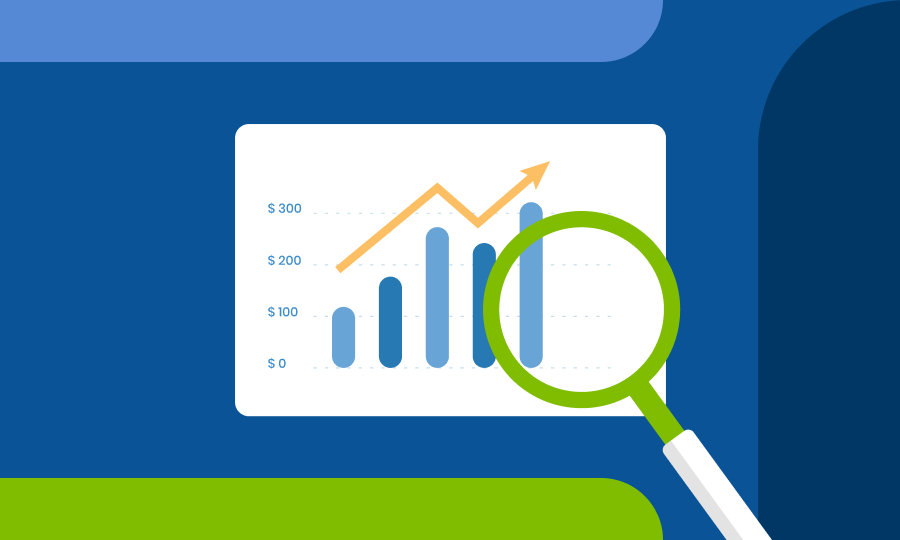Have you ever wondered how companies manage to anticipate market trends, predict financial risks or identify fraud before it happens? All this is possible thanks to a predictive model. In an increasingly data-driven financial world, the ability to predict future events based on patterns and historical information has become an indispensable tool for managers and professionals in the field.
In the financial sector, where one wrong decision can cost millions, the use of predictive models offers a huge competitive advantage. They allow companies not only to react to changes, but to anticipate them, proactively preparing for risks and opportunities.
Now, let's explore what exactly predictive models are and how they can revolutionize the way we work. processes your company's finances. Happy reading!
What is a predictive model?
A predictive model is a analytical tool that uses historical data and mathematical algorithms to predict future events or behavior. But although the term "predictive model" may sound technical, its function is simple: it transforms data into predictions, helping companies to make more informed and assertive decisions.
The role of a predictive model in finance
In finance, these models are applied to predict market variations, analyze the probability of credit default, detect fraud in real time and optimize investment portfolios, among other crucial activities, all based on statistical techniques.
In addition advantage of using a predictive model is that it allows finance teams to rely not just on past information or assumptions, but on forecasts based on concrete data and in-depth analysis.
Predictive models take on a new dimension when combined with artificial intelligence (AI) e machine learningThis allows predictions to become increasingly accurate as more data is analyzed. With AI, models can continuously "learn" from the information they receive, which is fundamental for financial processes such as risk analysis and fraud detection - find out more!
How does a predictive model differ from other technologies?
Predictive models differ from other analytical technologies mainly in their ability to predict future events based on historical data and identified patterns. Let's take a closer look at how they differ from other approaches:
Descriptive models
Descriptive models make a descriptive analysis of past data to understand what has happened. Although useful for providing a clear picture of what has already happened, they are not designed to predict future events. In contrast, predictive modeling uses the same historical data, but focuses on predicting what might happen in the future.
Diagnostic models
These technologies explain why certain events occurred, providing a detailed analysis of the causes and factors that influenced the outcome. While diagnostics seek to understand the past, predictive models project these findings into the future, trying to anticipate events before they happen.
Machine Learning (ML)
Although machine learning is often used in predictive models, they are not the same thing. ML is a technology that allows predictive models to learn and improve their predictions over time, but a predictive model can use approaches other than machine learning to generate predictions.
Prescriptive models
Unlike predictive models, which indicate what might happen, the prescriptive models suggest actions based on predictions. They use predictive data to recommend the best action to take to achieve the desired results.
What are the main uses and applications of predictive models in finance?
Predictive models in finance are increasingly important, especially in an increasingly data-driven environment. As explained earlier: they allow companies to make decisions based on future projections, using historical data and market variables. Let's explore in more depth how predictive models can be applied in the financial world:
Forecasting market trends
As market changes are constant and unpredictable, predictive models help to anticipate these variations by identifying patterns in historical data. This is crucial for financial institutions, investors and companies that depend on agile and informed decisions to maximize profits or minimize losses. The ability to predict the direction of financial markets makes it possible to adjust strategies and allocate resources more efficiently.
Credit risk analysis
One of the great challenges for any financial institution is to assess its customers' credit risk. With predictive models, companies can assess the likelihood of default based on a wide range of data, such as payment history and demographic data. This improves the accuracy of credit assessments, enabling companies to make more informed decisions and reduce losses from bad loans.
Fraud detection
Fraud detection is an area where predictive modeling shines, especially in times of increasing digital transactions. Machine learning techniques and artificial intelligence used in predictive models can analyze large volumes of transactions and identify atypical behavior that may indicate fraud. This allows organizations to act proactively, preventing damage and reducing financial losses.
Optimizing investment portfolios
The ability to assess the future performance of investments based on past data and market variables is a differentiator that predictive models provide. They allow fund managers and investors to identify the best investment opportunities and adjust their portfolios to maximize returns while minimizing risk.
Financial and budget planning
And finally, they are also powerful tools in budget planning, as they allow for greater precision in forecasting income and expenses. With these models, companies can better prepare for fluctuations in the market, allocating resources more efficiently and mitigating liquidity risks.
How does a predictive model work in the data preparation stages?
A predictive model needs high quality data to provide accurate and useful predictions. The data preparation steps in the process of creating a predictive model are crucial to ensuring that this data is ready to be put to the best use. Here's how it happens:
- 1. Data collectionThe first step is to extract data from various sources - such as financial databases, spreadsheets, ERPs or even external data. (such as economic indicators or market trends). This collection needs to be comprehensive and ensure that all relevant information is included;
- 2. Data cleaningThe data collected will not all be ready for immediate use. There are often errors, duplications or missing information. Cleaning involves removing inconsistencies and preparing the data so that it is complete and ready for analysis;
- 3. Data transformationIn this step, the data is normalized, converted into a common format and adjusted according to the model's requirements. For example, if a variable contains categorical values, it can be transformed into numbers so that the model can process it correctly;
- 4. Selecting featuresnot all the data collected is equally relevant. Here, analysts select the attributes that most impact the predictive model - such as selecting the most influential financial variables to predict a customer's behavior;
- 5. Data divisionThe data is then divided into training and test sets. The training set is used to fine-tune the model, while the test set is used to assess its accuracy in a "real" environment, ensuring that the predictions are reliable;
These steps ensure that the data used by the predictive model is consistent, clean and organized - which is essential for accurate and useful financial forecasts.
How do you build a predictive model?
This topic is for those who want to understand how to build a predictive model. Building one involves several crucial steps to ensure that predictions are accurate and relevant. Below are the main phases involved in building a predictive model:
- Defining the objectiveThe first step is to clearly define the problem or issue you want to solve. In the financial sector, it could be predicting the risk of default, projecting cash flow, or anticipating variations in share prices, for example;
- Data collectionAfter defining the objective, the next step is to collect data relevant to the problem. This data can come from various sources, such as ERP systems, CRM, financial databases, or even external data such as economic indices or market fluctuations;
- Data preparation and cleaningBefore using the data, it needs to be processed. This includes removing duplicates, dealing with missing data, and correcting errors. The quality of the data is essential to ensure that the predictive model works efficiently;
- Choice of algorithmThe choice of algorithm depends on the type of model you are building. For finance, some of the most common algorithms are linear regression, decision trees or neural networks. The aim here is to choose a method that is suitable for the type of data and the problem you want to solve.
- Model trainingHere, the data is divided into training and test sets. The training set is used to fine-tune the model, allowing it to "learn" from the historical data.
- Validation and adjustmentAfter training the model, it is validated with the test data set. This helps measure the model's accuracy and make adjustments, if necessary, to improve performance. Cross-validation algorithms are useful for this stage.
- ImplementationOnce the model is working well, it is implemented in the production environment. In the financial sector, this could mean integrating it into risk analysis, cash forecasting or fraud detection processes.
- Continuous monitoring and optimizationEven after it has been implemented, the predictive model must be monitored and adjusted regularly. Performance may vary over time as new data is collected, and adjustments may be necessary to maintain its accuracy.
Building an effective predictive model requires planning, knowledge of the data and constant review to guarantee accurate and reliable results.
What types of data are used in its construction?
In order to build a predictive model, the selection of data types is fundamental. In finance, the data used is widely varied and needs to be relevant to the objective of the forecast. Here are the main types of data commonly used:
Historical data
This is the data most commonly used in predictive financial models. They include time series of past prices, sales, cash flow, expenses and other financial indicators. Analyzing this data makes it possible to identify historical patterns that can help predict future behavior.
Transactional data
Transactional data is captured from the company's daily operations, such as purchases, sales and transfers. This information is essential for cash flow projections, default analysis and inventory optimization.
Demographic data
This data is mainly useful for analyzing customer behavior. It includes information such as age, location, income and consumption profile, and is essential for models that predict purchasing patterns or credit risk.
Market data
This is external information that includes economic indices, exchange rates, inflation and other macroeconomic indicators. This data helps adjust predictive models for external factors that directly affect a company's financial results.
Behavioral data
This data is used to predict the future behavior of consumers or customers. Information about purchasing frequency, payment behavior and service usage patterns helps to build more detailed forecasts about financial risks and opportunities.
How do you guarantee data quality for an efficient predictive model?
Ensuring data quality is essential to the success of a predictive model. Here are some important strategies to ensure the efficiency of the data used:
1. Data standardization
Standardization is key to ensuring that the data is consistent and comparable. This involves standardizing date formats, units of measurement and category nomenclatures so that there are no ambiguities that could distort the results of the predictive model.
2. Data cleaning
Before feeding a predictive model, it is necessary to eliminate duplicate data, correct inconsistencies and deal with missing values. Cleaning the data ensures that the model is not influenced by incorrect or incomplete information, which could affect its predictions.
3. Continuous review
The data used in predictive models should be reviewed and updated regularly. This ensures that the model is always working with the most recent and relevant information, minimizing errors resulting from outdated or irrelevant data.
4. Data governance
Implementing a data governance policy helps to define clear responsibilities for who can access, change and validate data. This creates an environment of greater control and confidence in the quality of the data used.
5. Automated quality validation
Tools ETL and data analysis solutions can include automatic quality checks, such as detecting anomalies or values outside the expected standards. Automating data validation significantly reduces human time and effort, as well as ensuring greater accuracy.
Keep learning | The complete guide to data quality
What technologies support predictive models in finance?
Advanced technologies play a crucial role in supporting predictive models in finance. Tools such as Big Data, Machine Learning e Artificial Intelligence (AI) enable analysis of large volumes of data and the creation of accurate forecasts. These technologies provide the basis for predictive models to interpret financial patterns, identify risks and opportunities, and optimize strategic decisions.
- Big DataThe most efficient way to collect, process and analyze large volumes of financial data quickly and efficiently;
- Machine LearningImproves the accuracy of predictive models by "learning" from historical data and adjusting predictions based on new data;
- Artificial Intelligence (AI)This automates analytical processes and enables the creation of more sophisticated predictive models capable of dealing with complex financial scenarios;
- Business Intelligence (BI) solutionsTools such as Power BI and Tableau help visualize and interpret the data analyzed by predictive models;
- Cloud Computingprovides the necessary infrastructure to process large volumes of data, ensuring scalability and flexibility to run predictive models efficiently;
- ETL platforms (Extract, Transform and Load)data is collected, transformed and loaded properly before being used in the predictive model.
These technologies are essential to ensure that the predictive model offers financial forecasts based on robust data and accurate analysis.
What are the future trends for predictive models in the financial sector?
Predictive models continue to evolve, and some trends are already beginning to shape the future of the financial sector. These innovations promise to further improve the accuracy and applicability of these tools, allowing financial companies to remain competitive and innovative.
- Real-time predictive modelsWith the evolution of data processing technologies, real-time forecasting is becoming a reality. This will allow financial companies to make instant adjustments based on new, real-time data, improving their ability to respond to changes in the market;
- Integration with Artificial Intelligence (AI) and Machine LearningAI and Machine Learning are playing an increasing role in building more sophisticated predictive models. These technologies allow models to "learn" continuously and adjust to new trends and patterns, providing more accurate forecasts;
- Automation and No-Code: the use of platforms no-code (without the need for programming) to create and implement predictive models democratizes access to these technologies, allowing professionals without in-depth technical knowledge to create and manage their own models;
- Focus on sustainability and ESG (Environmental, Social, and Governance)With the growing importance of ESG factors in the financial sector, predictive models are being adapted to include these criteria in their analysis, helping companies to predict financial impacts related to sustainability and social practices.
The Dattos is a no-code platform designed to streamline and automate complex financial processes, such as reconciliations and calculations. With more than 500 cataloged use cases and integration with more than 1,200 systems, we offer flexibility, precision and efficiency, allowing you to automate complex financial processes. financial teams focus on strategic decisions.
In addition Dattos IAIts integrated artificial intelligence turns data preparation into a simple task, where you can describe the steps in natural language and receive data ready for analysis. Talk to our experts and boost your team's potential!




